|
The date was March 13th 1944; the U.S. was
continuing their air offensive against the German aircraft industry which
started in January with the loss of 60 out of the 650 American aircraft used
in the first raid, the Russians were on the offensive and had pushed the
Germans back to positions they had occupied in early 1941 at the start of
the German invasion, the Americans were fighting in Italy on the eastern
front and the planned Allied landing on the coast of France was less than
three months away. In the west we were engaging the Japanese in the
Marshall Islands and Burma, while here in the USA, just two days before my 18th
birthday I was standing in line at the Bus Terminal in Philadelphia waiting
to get on a bus to the Navy Boot Camp in Bainbridge Maryland to begin my
service training. When, from the rear of the line comes this very large
Marine Sergeant, pulling people out of my line and forming them up behind
him, as he approaches my location I felt a pull on my arm and I raised my
enlistment papers and started shouting “you can’t do this to me, I wasn’t
drafted, I enlisted in the Navy and that’s where I want to be”. The
Sergeant looked at me and said “get back in line”, which I did and upon its
arrival I got on the bus to the Navy Boot Camp to begin my two years, two
months and seven days service in the Navy.
My experience in the Navy turned out to be great and
some might even say it was an all expense tour of almost three quarters of
the way around the world. It is true we did travel east to Tunisia on the
Mediterranean coast of North Africa, west to Shanghai, China, south to North
Borneo and north to England and Japan. My Tour was paid for by Uncle Sam,
plus with sea duty pay I also received $72 per month for expenses, but, you
must also consider the one thing that could mess up this life of bliss was
that we were traveling in oceans that were also hunting grounds for enemy
submarines and aircraft, I consider myself very lucky that it didn’t turn
into a disaster. I say lucky because I had nothing to do with it, no acts of
bravery on my part, I did a few dumb things when I was on liberty but,
mostly I was just there for the ride. Of course I would have a more
interesting story to tell if I had not been lucky, but I have managed to
live with that.
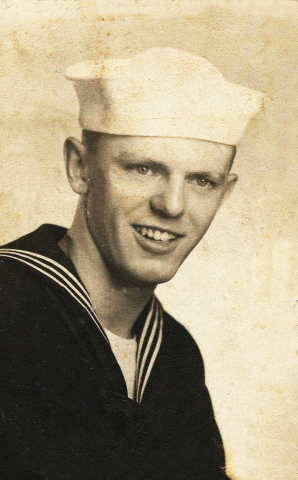
After less than one month training at Boot Camp I was
given a nine day leave and when I returned to Bainbridge I was promoted from
apprentice seaman to Fireman Second Class and sent to a Machinist Mate
Training School at Norfolk Virginia. I spent four months at the school
learning how to operate various machine tools including a turret lathe where
I spent most of my time turning out metal hand wheels. Upon completion of
the course I was promoted to Fireman First Class (same as 3rd
class petty officer or corporal in the army) and sent to New York city, Pier
92, where on August 27th 1944 I went aboard my ship, the USS
Enright DE 216, a Destroyer Escort, mainly used as a convoy escort ship for
defense against enemy submarine attack.
I was assigned to the number 2 boiler room as my duty
station (where, along with number 1 boiler room, the steam is generated to
run the ships steam turbines which in turn rotate the ships propellers). We
worked at our duty station in shifts of 4 hours on and 8 hours off, the
other 4 hours during the day we did cleaning and maintenance of the
equipment in the Boiler Room.
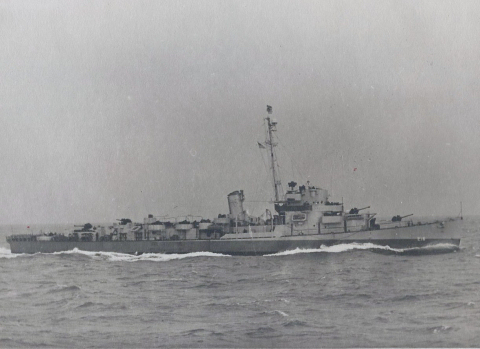
My first trip was for gunnery practice in the North
Atlantic off the coast of Maine and New Hampshire.
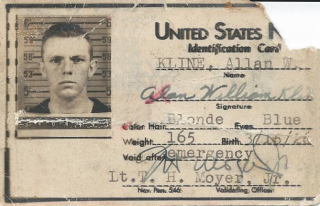
For my battle station (when the ship is in
action) I was assigned to the 3 inch gun mount as phone man. I considered
this a pretty good job, I was phone man, I gave the gun crew their firing
orders, of course I really only repeated what the officer on the bridge told
me to say. My career as a phone man on the gun crew didn’t last very long,
during my first session as phone man I heard and relayed the “commence
firing” orders to the gun crew but, after the gun started firing I
didn’t hear anything else. After a short while I saw an officer come off the
bridge and down two ladders to the deck I was on. The Officer came over,
cupped his hands over his mouth to form a megaphone and shouted “cease
fire”. At that point it didn’t matter if I heard the order or not because
the gun crew heard it and stopped firing. The officer removed the ear phones
from my head and sent me to sick bay to get my ears checked. My next battle
station assignment was assistant loader with the 40 mm crew; it was my job
to retrieve the clips, each containing four 40 mm shells, from the storage area inside the barbette shield
surrounding the gun mount and hand them, one clip at a time to the gunnery
mate, loading the gun. I continued working with the gun crews as my battle
station assignment for the rest of my time on the USS Enright. My duties varied
from adjusting sights on our main three-inch 50 caliber gun to loader on the
20 mm and 40 mm antiaircraft guns and I got a lot of fresh air and experiences
I might not have had if stationed somewhere else.
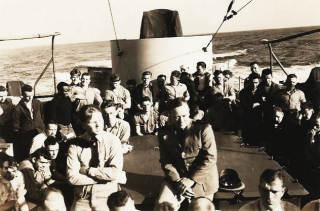
On September 5th we joined up with nine other Destroyer
Escorts to provide protection to 43 merchant and troop ships headed for
Cherbourg, France. The ten escorts were positioned in the form of a V, with
five escorts on each side of the convoy. The main purpose of the Escorts was
to protect the front and sides of the convoy from submarine attack and keep
the subs from getting inside the screen. Once the convoy passed, the
submerged submarine could not catch up and attack from the rear, unless it
came to the surface where it was subject to being fired on or rammed by the
ships in the screen. The
submarines of that era were driven by diesel engines while traveling on the
surface but, when under water they used battery power which limited the
underwater speed to 9 knots (10 miles per hour), The escorts could go 20
knots but, we traveled in a zigzag evasive pattern to ward off a torpedo
attack which lowered the convoy speed to less than 15 knots.
The escort ships had sound detection systems, similar
to a radar system that would send sound waves down to the bottom of the
ocean which would bounce off any hard surface and return a signal to the
detection system on the ship, the time interval between sending the signal
and receiving its return would indicate the depth or range of the object and
if it was a sub, a large fish or wreckage would be indicated by the strength
and characteristic of the return signal. From this information a good
operator could usually determine what the object was. The USS Enright had
several contacts during the trip and although we did not see or have any
indication of destroying a submarine, our attack was very spectacular. The
ship that made contact would pull out of the screen and head toward the
contact while hoisting a large black flag with white crossed bones on the
main mast and blasting a very loud Klaxon horn (the other ships would move up to
fill in the gap in the screen). The Destroyer Escort had depth charges (55
gallon drum filled with explosives and containing a pressure sensitive fuse)
stacked on racks at the stern and mounted on K-guns on both sides
of the ship. As the attacking ship approached the target it would start to
discharge the depth charges into water from the racks and K-guns as it
traveled over the targets location, the resulting explosions would erupt the
ocean around the ship as it continued dropping charges until the convoy had
past. The ship would then abort the attack and return to its position in the
convoy. We continued this until we safely arrived at Cherbourg, the destination port
on the coast of France.
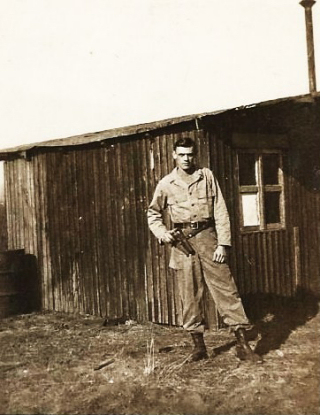
We did not stay in Cherbourg but, instead went across
the Channel to Portsmouth England. As we entered the port we hit a buoy and
damaged one of the ship’s propellers, requiring us to go into dry dock for
repairs. The repairs took several days so, I was given a day off to visit
England and I decided it would be a good time to visit to my Mom’s family.
My brother, Ray (photo on right) was stationed with the 64th
Aerodrome Squadron
based in England at the time and knew my Mother’s family very well. Shortly
after I arrived at the London train station they had an air raid and it was
necessary for me to spend several hours in the air raid shelter waiting
until the all clear signal was given. By now it was late in the evening and
I didn’t arrive at the London's North Finchley Station where my mother’s sister, Mrs. Ellen (Nell) Fitch,
lived at 25 Limes Avenue until after midnight, this
was the last stop for the train and it was about to head back to London. I
did manage to call my Aunt before returning to my ship which by now was out
of dry dock and preparing to set sail for the States. We had a safe return
trip with no surprises and when I arrived on October 3rd 1944. I was
given an eight day leave. My friend, John Bender was also home on leave at
the time and we bar hopped together. I also met a young lady named Ann Davis
from north Camden, NJ at a dance and we went out several times during my leave.
|
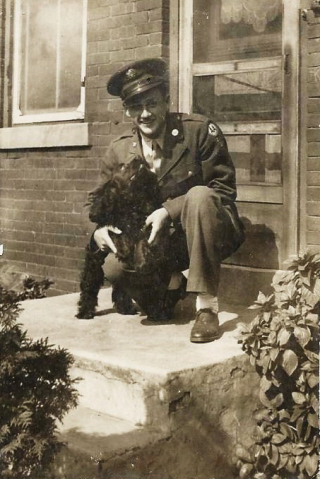 |
|
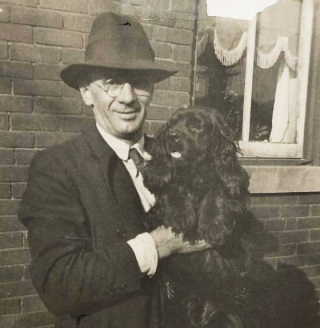 |
|
My friend, John Bender |
|
My Dad
|
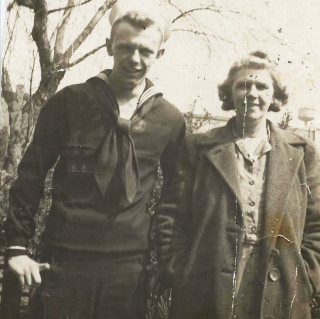 |
|
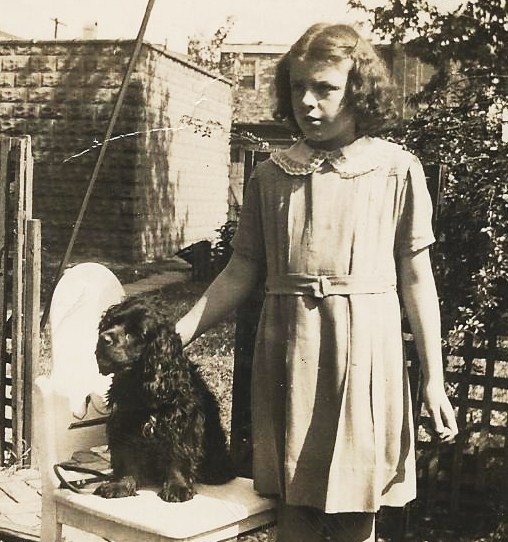 |
|
Mom and Her Sailor Boy |
|
My Sister Janette |
|
|
|
After I returned to my ship we sailed north for gunnery
practice off the coast of Portland Maine, My General Quarters (GQ) duty was now sight setter
on the 3-inch gun, I don’t remember what that involved but, it sounds better
than assistant loader. We traveled south to Norfolk, VA to meet our next convoy
and on November 1 1944 headed for the Mediterranean Sea port of Bizerte, Tunisia
in North Africa. The trip took 21 days and was about the same as
the previous convoy; we did not have liberty in Bizerte but, did manage a
couple of hours in the seaport town of Oran in Algeria. On our return to the
States we refueled at Ponta Delgada in the Azores Islands off the coast of
Portugal. As we first enter the port the buildings on the beach resemble one
large fort but, as we approached you could see that they were individual
buildings painted to resemble a fort. We left the Azores and headed for the
States arriving at New London, Connecticut on December 1st. We practiced
evasive tactics with submarines until late January, then to Boston Harbor
where we entered the shipyard for conversion to an Auxiliary High Speed
Transport (aka APD), a Destroyer Escort
modified to carry 150 troops in addition to the crew members. Rumors had it
that after completion of the modifications we were headed for the Pacific
Ocean. The crew moved off the ship to shore barracks during the
conversion and I got assigned to the spud locker which meant that I prepared
potatoes and other vegetables for the meals, it also allowed me go into
Boston every evening and take dancing lessons, meet girls, go skating, meet
girls or anything else I wanted to do including meeting girls. Because there
were plenty of them around and their boyfriends were overseas. I also got
several eight day leaves to go home. On one of these visits home I called up
a friend I had met at the Gloucester, MA skating rink during my pre-Navy days
and asked her if she would go skating with me. Honey was engaged to a
soldier who was serving with General Patton’s Army, agreed to join me and
said her sister would come also. I borrowed my dad’s car, met Honey and her
sister Terry at their home in Cramer Hill and drove to the skating rink.
Terry was not a skater and I had to hold her up most of the time we were
skating together so, naturally I got tired of this and spent most of time
skating with Honey. This did not make Terry a happy girl because when I took
them home, Honey went into the house and as I tried to kiss Terry she jumped
back and said “if you want to kiss someone, kiss my sister, you skated
with her all night.” I figured that this girl is mad and I will probably
never see her again. Little did I know that Terry Frances Chapman would become
my world.
On March 13th 1945 I celebrated my first
year in the Navy and on March 15th, my 19th birthday
and we moved back on my ship, now the USS Enright APD-66. I was still
assigned to the No. 2 Boiler Room but, my duty station had moved up to
tending the Boiler. This was not a promotion but, only a little more
interesting work assignment. Other than that my
duties remained the same, including my Battle
Station assignment where I would be getting plenty of fresh air on the gun
deck during our planned trip to the Pacific.
We left Boston on March 28th 1945 and proceeded
South to Norfolk, VA and on to Miami, FL conducting training engagements with
American submarines and aircraft along the way and arrived at the Panama
Canal on April 17th. We went through the locks to Balboa Panama
then up the west coast to San Diego, CA and west to Pearl Harbor, HI. On
May 7th 1945 Germany surrendered, the war was over in Europe and
the USS Enright was boarding an Underwater Demolition Team (UDT) for practice beach clearing
operations on several islands in Hawaii. The UDTs were used, during an
invasion to clear the beaches of mines and other anti invasion structures
before the invading forces arrived. The training as well as the actual beach
clearing was done at night. The APDs were constructed for use as the” Mother
Ship” to support the teams during an invasion. We were too late for use
during the invasion of Okinawa but, probably would be used for the invasion
of Japan. It was our job to take the team close to shore where they would
launch inflatable boats to get to the area to be cleared. We would remain in
the area until they returned and were secure on board our ship. We did this
for about two weeks and after having our last liberty in Hawaii, boarded 150
passengers and joined a DE to escort a group of Navy Transports, APAs, west
to Eniwetok in the Marshall Islands.
Eniwetok is seven miles long and less than one mile
wide. It is the largest of 15 islands that form an atoll or narrow ridge of
land that encircles a large body, or in this case 600 square miles of ocean.
There are many atolls in the Marshall Islands and thousands more throughout
the Pacific. The islands making up the atolls are the tops of very steep
mountains extending from the Pacific Ocean floor.
Our location on the globe is now eleven degrees north
of the Equator and eighteen degrees west of the International Date Line as we leave Eniwetok and head northwest to Ulithi Island another
atoll in the Carolina Islands. We went ashore on a small island in the
atoll. The island had a fence separating the troops from the natives of the
atoll who had come to the island to sell their wares to the troops. I bought
a few things and mailed some money home at the post office on the island.
We left Ulithi and headed north to the East China Sea
and on June 11th, 1945 arrived at Okinawa, an island in the Ryukyu Chain
which is located between Taiwan (Formosa) and Japan. Okinawa is 66 miles
long and 3 to 10 miles wide, the Allies invaded the island on April 1945, first
with 180,000 combat troops, 368,000 support troops and 1320 Navy Ships, it
was the largest amphibious operation in the Pacific during the war. We
joined up with other escorts on Picket Duty in the East China Sea protecting
the ships in Naha Harbor from submarine attack and stayed in the area for
the rest of June. Enemy planes were in the sky day and night, they were
either out of our firing range or being engaged by our aircraft. The dog
fights at night were very spectacular, we were usually at battle stations
and from my position on the gun deck I could see the explosion when a plane
was hit and the sky light up as it fell into the East China Sea, it appeared
that the pilots went down with their planes. While we were refueling in Naha
Harbor we witnessed a Kamikaze plane fly into an Landing Ship Tank (LST) that was docked just
across from us, the plane hit the massive ramp doors on the Landing Ship and
fell into the water. Our closest encounter came when an enemy plane flying
behind an American aircraft , to avoid detection, dived on us, flew over our
mast and dropped two bombs which straddled our ship and exploded in the
water, one behind our stern, the other forward of our bow. From my “front
row seat” at my battle station I could see flames coming out of what was
probably the plane’s exhaust, thinking it was hit I shouted out, “we got
him” several times as the plane flew over. The USS Enright’s guns had not been
fired.
We were all very excited about our close encounter and
how lucky we were, no one mentioned my shouting and I certainly didn’t, but
lucky we were. During the 3 month Okinawa campaign the Navy lost 36 ships
and 368 were damaged, most from enemy air craft and submarines. The subs
were in the area, our sonar detected them, one enemy torpedo exploded in
our ship’s wake, and we dropped plenty of depth charges, killed a lot of
fish but, as far as I know no submarines were killed, so I guess we were even.
Organized and most mop up fighting was completed by the
end of June 1945 but Okinawa was still being attacked by enemy aircraft until
Japan’s surrender in mid August. We left the Picket line on July 1st
to escort a communication ship to Leyte in the Philippine Islands and
arrived there 3 days later, just in time to celebrate the 4th of
July with the ship anchored in the harbor, having turkey and fresh churned
ice cream for dinner. Food wise the Navy had it good. The next day, July 5th
1945 the organized fighting was over and the Philippine Islands were
declared secured. Mop up operations were still going on in the southern
islands near Borneo until mid August
We stayed in the Leyte area for two weeks enjoying
going ashore on the small islands in Leyte Gulf for swimming and beach
parties. On one Sunday they held boxing matches aboard the ship. I entered
and lost by a decision, we used big boxing gloves, nobody got hurt and it
was fun.
We left Leyte and joined up with a destroyer and seven LSTs and headed north back to Okinawa. While still in the Philippine Sea we
picked up a submarine contact and started dropping depth charges around the
contact area. We continued patrolling for the Sub until the next day when
two destroyers took over the task and we headed north to join up with the
convoy. When we arrived at Okinawa it was under a severe typhoon, Naha Harbor
was closed and we joined other ships to ride the storm out at sea. During
that evening one of the ships got hit broadside by a very large wave which
caused it to roll seventy degrees and take sea water down the stack. When
this cold sea water came in contact with the superheated steam drum it
caused an explosion. I don’t know how much damage the explosion did but, it
could have killed members of the fire room crew.
After the storm we returned to Naha Harbor to refuel
and pick up another convoy for escort back to Leyte. Things were warming up
now and the fleet was getting ready for the invasion of the Japanese
Islands. We left Okinawa heading south and when we were one day out picked
up another submarine contact in the Philippine Sea. The sub was probably not
a threat to our convoy and we were the only escort so, we stayed with the
convoy and arrived at Leyte Gulf on July 24th. It turns out that
six days later, July 30th an enemy sub torpedoed and sunk the
heavy cruiser USS Indianapolis in the Philippine Sea.
By that time we had already been given another
assignment and were heading south to the Southern Islands and Borneo to
deliver mail and passengers. We stopped at Lloilo on the Isle of Panay;
Puerto Princesa on the Isle of Palawan; Cebu on the Isle of Cebu; Zamboanga
on Mindanao and finally Brunei Bay In Borneo. We did not go ashore at any of
these places but, island people came out in boats selling their wares and
diving for coins. One evening we were approached by a covered boat and the
man on board flashed a light inside the covered area revealing a beautifully
decorated woman dressed in a red and gold long gown and invited us to slide
down the anchor chain for a good time.
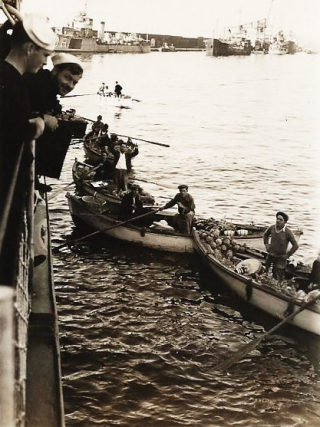
We made one more mail run to the same islands and while
on that trip the Air Force dropped the “A” bomb on Hiroshima, August 6th
and on Nagasaki, August 9th. On August 15th the
Japanese agreed to an unconditional surrender. The Japanese surrender took a
while to spread to other countries still engaged like China and Russia,
also, there were still submarines that did not get the word so, we still
traveled in convoys and maintained war alert.
On August 21st we joined a 5 inch DE to
convoy two Auxiliary Ships to a position 300 miles south of Tokyo where the
Fleet was assembled waiting for orders. When we arrived we circled the area
for two days and then joined the DE for the return trip to Leyte. On the
first night out we hit another storm and had to cut our speed to seven
knots. Storms occurring between Leyte and Japan happen often and are very
bad. If you head into the storm too fast the bow will rise out of the water
and then slam down causing a heavy shudder through out the ship. This is
very damaging to the ships structure so you slow down and the ship rolls
side to side. We had been traveling back and forth in the area for almost
three months so most of us got used to it, but a few including some of the
mess cooks never did. You see some awful sights while waiting in the mess
line for your meals during a storm.
The official signing of the Japanese surrender was held
on board the USS Missouri anchored in Tokyo Bay at eight am Sunday morning
on September 2nd 1945. We were in Leyte getting ready to leave
for Manila, where we would join a convoy and head north to Japan. The last
time we had liberty in any city was the middle of May when we left Pearl
Harbor, so we were hoping that this four month streak would end soon. Well
it didn’t in Manila when we picked up the 27 LSMs (Landing Ship Medium) and headed north to
Japan, arriving in Tokyo Bay on September 17th. A storm had hit
the area so we continued north to Sendai on Honshu Island. We went ashore
several times for beach parties on small islands in the area, on one of our
shore trips, after we played ball and finished our two cans of beer four of
us took a stroll away from the beach. As we walked back into the island you
could see that people lived there because many of the hills had been
terraced to provide flat plots for gardens, as we continued we came across a
small village. A group of women standing around talking noticed us as we
approached and immediately went into their houses or what looked like grass
huts. Pretty soon about twelve or more men came out of the huts and came
toward us. Naturally we were not armed and it didn’t appear they were, we
stopped walking and waited for them to come to us. It turned out that one of
the men had been a radio operator on a ship that had traveled between Japan and
San Francisco and could speak English. We were invited to his home which was
a well constructed woven grass exterior building, served tea, talked a while
and then returned to our ship. We were pleasantly surprised that they had
been so friendly because we had no idea what was going to happen when they
started to approach us. Approaching this village had been a dumb thing
because although I don’t think any of us would have done harm, they didn’t
know that and just two months before we had been bitter enemies. We
continued to see this friendliness by the Japanese as we made our way around
the island of Honshu and back to Tokyo Bay and our first liberty in a town
or city since we left Hawaii.
Tokyo had been cleaned up since the bombing. Whole city
blocks were void of buildings but, the rubble had been neatly piled up at
the end of the block ready to be taken away. We passed General Douglas MacArthur’s
headquarters and as we were crossing the street he came out of his quarters
and drove off with his driver.
We had been in Japanese waters for five weeks and it
was time to move, so we joined two other APD’s, APD-65 and APD-72 for our trip back
to Manila. We had good weather all the way and the three ships played follow
the leader doing all types of turns and maneuvers, this was tough on the
fire room crews but we enjoyed the challenge and tried to keep up. I was too
far down in the hole to have any association with the ship’s Captain or any
of the officers but they seemed to know what they were doing. We had a well
run ship, there was no bullying from the people in command, they just
expected you to do what they asked and we did. We were kept busy but, still
had time off for beach parties, movies or shore liberty when possible. The
crew responded positively, worked hard and effectively, the ship was ready.
When we were requested to go somewhere we went and the best part we came
back. The Chief Water Tender was my main point of contact and I kiddingly
asked him when he was going to give me a second class rate. His answer was
that I would not make a pimple on the rear end of a water tender, but to my
surprise shortly after that I was offered the rate. I turned the offer down
after I found out that the rate was frozen and that I would probably be
transferred to another ship and remain in the area when the USS Enright returned
to the States.
We arrived at Manila Bay on October 31st and
stayed two weeks working on the boilers in the fire room and on liberty in
Manila. The city, the largest on the island of Luzon suffered a lot of war
damage. It had been occupied by the Japanese from December 1942 until
February 1945. They were starting to get back but there was still a lot of
clean up to be done. We could count the masts of 20 sunken ships within a
one mile radius of our anchorage. I think it was while on liberty in Manila
that several of us decided that we would play “real navy” and have a couple
of beers and go find a cat house. I don’t remember how we found it but it
was on the water front and in a not too friendly area. We paid to enter the
building, walked down a hallway and each of us entered a separate room.
As I entered my room I saw what appeared to be an old, very hard looking,
naked woman sitting on a bed. She didn’t speak English but, motioned for me
to come over, I won’t give you any more details, it will probably bore you
to death, I know it did me. When I left the room I put a big grin on my
face, went outside and told my friends how great it was.
We completed our work on the boilers and boarded 150
passengers for a trip to Shanghai China. We headed to the East China Sea
where on two occasions our radar picked up floating mines, which we
destroyed and arrived at the Navy base on the Whangpoo River in Shanghai the
day before Thanksgiving (see photos below).
We stayed four days, had one liberty which I enjoyed
riding in rickshaws all over the down town area. For our return to Manila we
boarded a group of interned Philippine musicians named Loupes Band. On our
way to Manila we made an overnight stop at Okinawa where the band
entertained us with a concert .
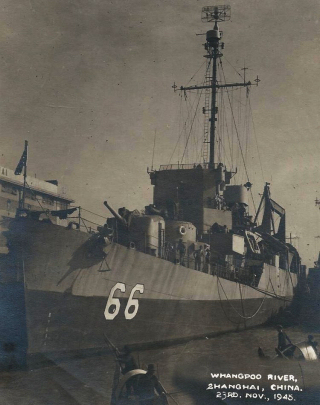 |
|
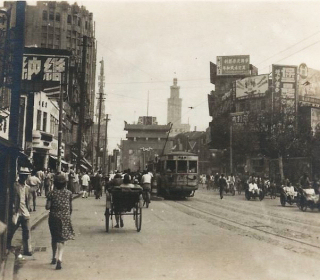 |
|
The USS
Enright (APD-66) Docked In Shanghai |
|
Enjoying A
Rickshaw Ride in Shanghai |
Loupes music was high brow compared to what we were
used to from the ship’s PA system. One song still sticks in my mind, One
Meat Ball by Hoagie Carmichael, I think the lyrics were “you get no bread
with one meat ball.” It really got my moves going. After leaving Okinawa, we
had to go 180 miles off our course to pick up two sick Navy men off a ship
in the Philippine Sea. As we returned to course and approached Luzon Island
a sea plane came out, landed on the water and boarded the sick men for
delivery to the hospital.
After our return to Manila we discharged our band
passengers and took on 200 high point men that were returning to the States
for discharge. Yes, we were going home. We were scheduled to make fueling
stops in Eniwetok and Pearl and arrive in San Diego just before Christmas.
As we came out of the San Bernadino Straights into the Philippine Sea we hit
another storm which slowed us down for three days until we refueled in
Eniwetok. As we were heading east to Pearl and while working on my cleaning
station I discovered that a section of the ship’s haul had rusted out and
sea water was seeping into the boiler room. The hole was above the water
line and not an immediate problem, I notified the duty officer and he
relayed the information to the captain. The decision was that the ship’s
welders would make the repairs rather than go in to dry dock and delay our
return to the States. The ship’s welders made the repairs when we got to
Pearl and we arrived in San Diego on Christmas Day three days less than
eight months after we left.
We left three days later, went south to Balboa Panama
and east through the Panama Canal and up the east coast of Florida and in to
the St. Johns river to Green Cove Springs, just south of Jacksonville where
we tied up to a group of DEs and APDs already being decommissioned and
preserved for future wars. I worked on the USS Enright for four months and then
a group of us now high point men departed by train to Lido Beach, Long
Island New York where I was discharged on May 20th 1946 to end my
two years two months and seven days service to my country.
I was lucky and can actually say that I enjoyed my time
in the Navy but now that my duty was finished I was more than ready to get
on with my life as a civilian. I had very little money saved, barely enough
to buy a used car, maybe a very old used car and I did not have a High
School diploma, but I had several things going for me, namely, I was just 20
years old and did not consider being without savings or a High School
diploma a problem. I knew that I could live at home and my Navy severance
pay was twenty dollars a week for one year, enough for pocket money. I had
graduated from Vocational School as a draftsman before joining the Navy and
my work experience and training qualified me to be an apprentice in a
machine shop. Not many twenty year olds had this much going for them so I
felt that I was in great shape for my future. Since I had a diploma from
CCVS in drafting I chose that field for my job search. My dad bought me a
new suit and also paid me an hourly rate to help out at a house he and Ray
were building in Mt Ephraim, a small town south of Camden. So, I had a new
suit, a few extra bucks in my pocket and with the aid of the want ads in the
news paper found a job at the Riverside Metal Company in the drafting
department of their Watch Case Division. My job was to make manufacturing
drawings of watch cases from metal models and artist conceptual sketches and
add the necessary details to insure that the watch components fit correctly
inside the case. For this very important sounding task I received less than
seventy five cents per hour, when the federal minimum hourly wage was raised
to seventy five cents shortly after that I got a raise.
About that time I bought a 1936 Dodge, used cars were
expensive because during the war years the auto industry only made military
vehicles. The 1946 model was probably the first new car produced since the
war started. My Dodge had been used as a taxi and had a lot of miles on it
but it ran good and I could usually fix anything that went wrong with it.
So, I had my first job and my wheels to get there.
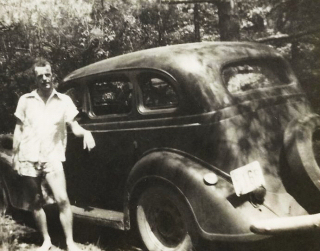 |
|
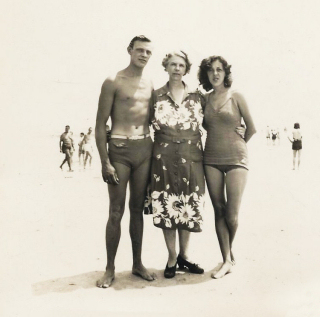 |
| My 1936 Dodge |
|
Ray, Mom and Tina |
| |
|
|
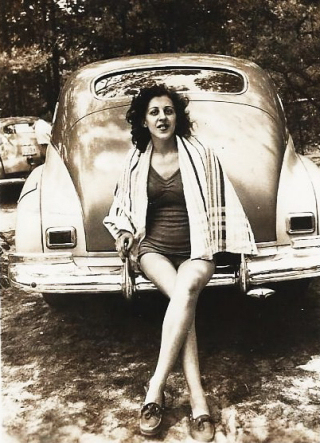 |
|
Tina |
|
|
|
I made another career move in August of 1946 while at
work when I noticed another draftsman getting ready to leave; I casually
asked what he was doing that evening. His reply was that he was going to
Drexel University, in Philadelphia to register for the fall term at the evening
college. I had never considered going to college before but since the VA
would pay for it and I had the time available, I decided at that moment to
go with him. At that time the Drexel Evening College only offered an
Associate diploma, they later changed to offering a Bachelor’s Degree; they
did offer the necessary High School courses to cover what I had missed. The
classes were three hours each and I attended three nights each week for
three semesters a year summers off and received my Associate diploma in
Mechanical Engineering in June of 1955 and my Bachelor of Science Degree in
June of 1957. In those days most of the Defense Contractors provided college
tuition to employees, they also had the best paying jobs and most
interesting work so that is where I went when the VA stopped paying my
tuition.
I was still going out with Ann Davis, a girl I had met
at a Catholic dance when I was home on leave from the Navy. We usually went
dancing, that was until one evening she phoned and told me that she could no
longer go out with me because I was not Catholic. Well, this took me by
surprise, I didn’t realize it showed, we had never talked about religion
before and I wasn’t sure that this was the real reason for the dump. I liked
Ann, we had a lot of fun together and having attended Catholic mass in the
Navy I didn’t think it was that much different than my church but, I was not
ready to get serious and probably a little miffed besides, we stopped
dating. I was just dumped because I was not Catholic so what do I do, I
started going back out to Catholic run dances, I liked Catholic dances, they
had four intermissions and you could buy beer.
I kept busy with work, school,
home work and I usually went out on weekends. My sister-in-law Tina took me
on as a project, she said that I drank and cursed too much, so to give
little more class she set up dates for me with her friends and I guess I was
not ready to take on any more responsibility because they fizzled out. That
was until the fall of 1947, it was a Saturday evening and several of us
decided to attend a dance in Pennsauken, a small town that I would pass on
my way to work. We had been there before and it was put on by, you guessed
it the Catholic Church. Things started to liven after the second
intermission and it was about that time that I noticed this girl that I
recognized as someone I had met before. I figured that would be a good
conversation starter and walked up to her and said “I know you”, I was going
to ask if she remembered me but before I got the words out she looked at me
and said “oh no you don’t.” Well, this ended the conversation but I suddenly
remembered who she was, this was Honey’s sister Terry and she was still mad
at me from the skating rink. This set me back for a while and later when I
asked her to dance, she answered “yes if you quite hopping around when you
dance”. This conversation was not doing my ego any good but I must have
loved it because I danced with her the rest of the evening, I noticed while
dancing that Terry kept pressing on my shoulder to remind me not to hop
around when I started to feel the music. I called Terry the following week
for a date and she told me to call back later for an answer. When I called
later I expected that the answer would be no but, to my surprise she said
yes, I think her sister put in a good word for me. Although I did not
overwhelm Terry with my charm when we met at the dance it was the beginning
of a very happy life together. We got married eight months later in June of
1948. Yes, I turned Catholic and we were married in her church.
Because of my work during the day, attending college
classes three evenings a week and homework requirements our dating during my
courtship of Terry Chapman was limited to weekends. Two things stand out in
my mind during this time; one was my first dinner at the Chapman house.
Terry’s mother, Florie was very outgoing and her father, George an engineer
for the railroad was on the quiet side. We talked and joked a lot with
Florie during the meal, I felt right at home because my family did the same.
Before we finished our desert George jumps up and starts taking the dishes
into the kitchen and washing them. Everyone at the table ignores what’s
going on and continue talking. After completing the dishes, George comes
back in the room with a broom and starts sweeping the floor. Other than
raise their feet to allow him to sweep no one pays any attention to George
who is sweeping away, mumbling under his breath about the #%xx$# people
sitting around talking all day. After the sweeping is completed every one
left the table, George came back in the room with a deck of cards, sat down
at the table and said “let’s play cards.” Terry’s dad was an entirely
different person with a deck of cards in his hand, very outgoing, in
complete charge and when you played against him you had the feeling that he
knew every card that was in your hand.
The second fond memory involved the Chapman’s front
porch. Florie’s father who retired after owning a store in Philadelphia
occupied the front porch during the day and it was where we would sit in the
evening after our dates. Just about the time that we would get into some
very serious “making out”, George, who worked the evening shift, would
arrive home making a lot of noise coming up the porch steps as he entered
the house. He would look us over, mumble something, and head up the stairs
to report the situation on the porch to Florie. If there was anything at all
out of order Terry would hear about it the next day. I guess Terry was a
little miffed because she was getting all the blame, it didn’t seem to be a
problem to me. I guess we had other options but, we continued to use the
porch.
I don’t remember when we got engaged, I know I didn’t
do anything spectacular, we just sort of agreed to do it. My boss at the
Watch Case Company was in the jewelry business and I asked him to get me a ring.
He bought me a real nice one with a nice size stone for seventy five
dollars, Terry loved it. When she showed it off at work, one of the girls
told her it had a yellow spot, this wasn’t one of my better days, but then
again it wasn’t my worst one either.
Well, the day finely came, our wedding day. I had
already converted and we were married by her parish priest. Terry’s mom and
a group of the church women cooked the food and held the reception in the
Church hall. My Dad brought in a keg of beer and we had a great time.
Terry’s sister Mary was her maid of honor and my friend John Bender was my
best man, they did a great job helping us join together for a wonderful
future together. That was the best day of my life and the worst was on April
7th 2005, the day she died in a helicopter on the way to the
Hospital in Jacksonville, after playing a round of golf and an evening of
Mahjong with her lady friends two days before.
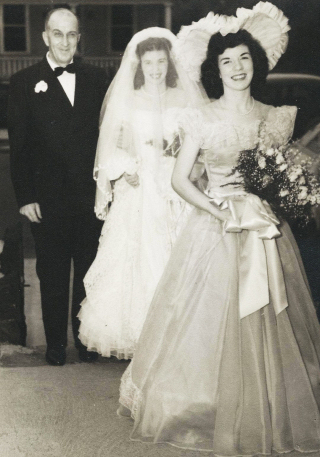 |
|
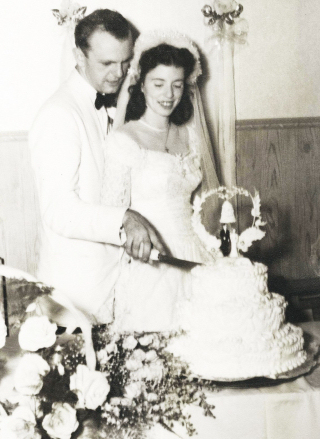 |
|
George Chapman (father-in-law), Terry and Mary Chapman
(maid-of-honor) |
|
|
| |
|
|
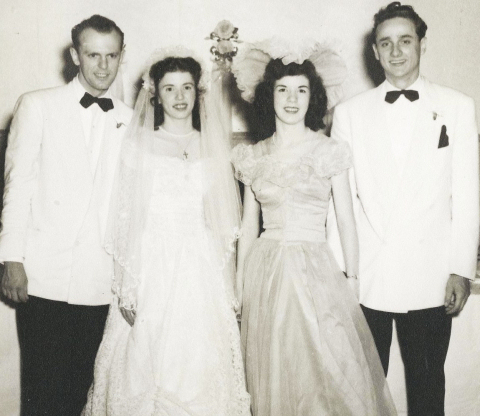 |
|
Maid of Honor:
Mary Chapman
Best Man: John Bender |
|
|
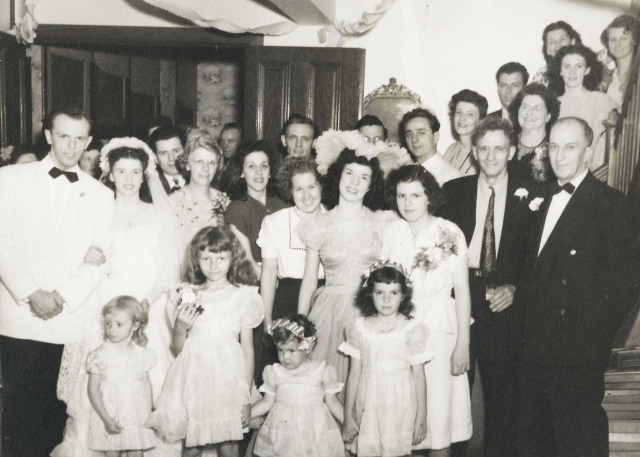 |
|
left-to-right
Back row: Buddy Chapman, Ray Kline, Al Chiddenton, Edna
(Chapman) Rich, Joe Chapman, Sis (Chapman) Purdy.
3rd row: Next; My Mom, Ray’s Tina, Buddy’s Millie, John Bender,
Terry’s Mom, Honey (Chapman) Chiddenton, Joe’s Ellie
2nd row: The Groom, The Bride, Mary Chapman, Janette
Kline, My Dad, Terry’s Dad.
Front row: Joe’s kids; (Kathleen and Dotty) and Sis’ kids;
(Frances and Ann)
|
| |
|
|
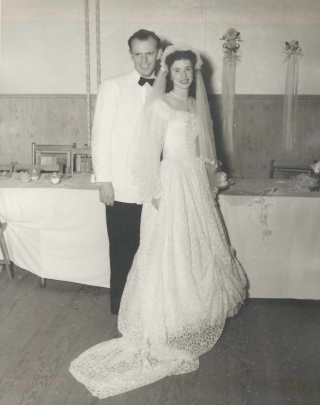 |
|
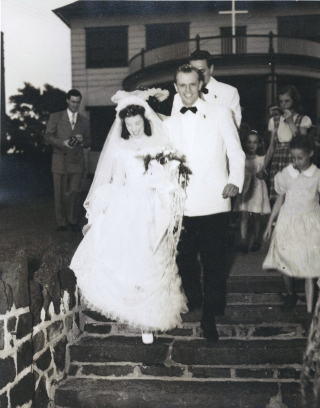 |
| |
|
|
|